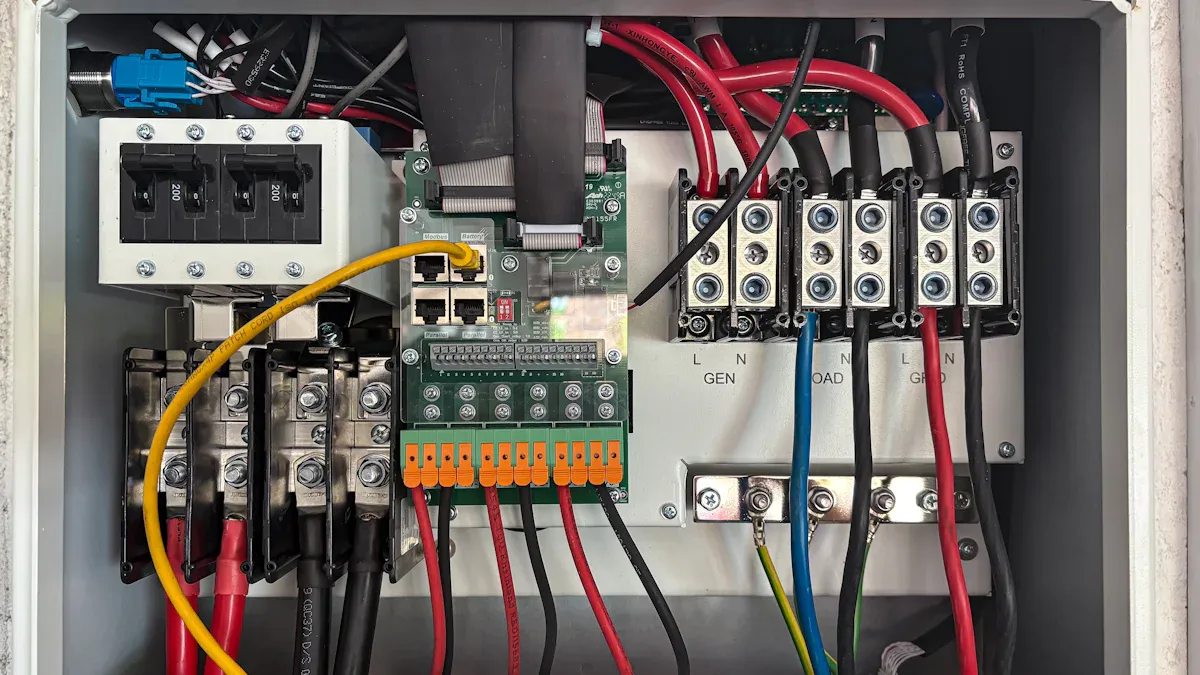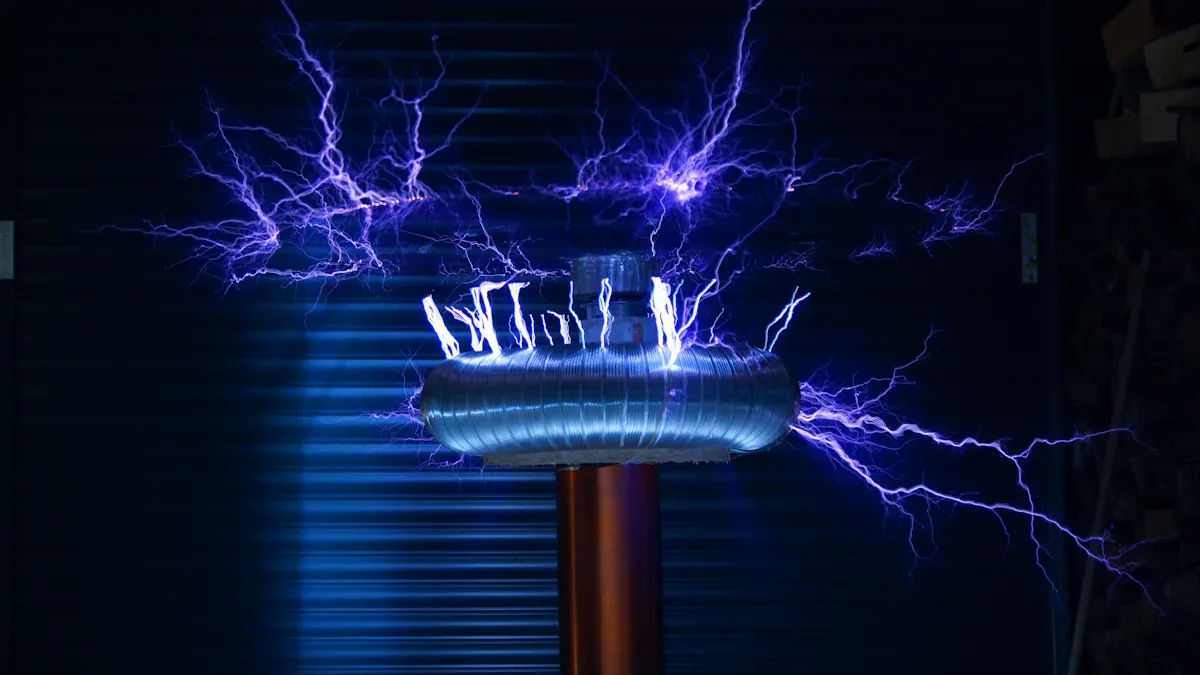Do You Need ESTEL Fireproof Cabinets for Lithium-Ion Battery Storage

Storing lithium-ion batteries comes with significant risks if you don’t use proper safety measures. These batteries can overheat, triggering a phenomenon called thermal runaway. This process can cause a fire that spreads rapidly. A fireproof battery storage cabinet minimizes these dangers. It creates a secure environment that contains potential fires and prevents damage. By using this solution, you protect people, property, and your business from harm.
Key Takeaways
Lithium-ion batteries can get too hot and start fires. Fireproof cabinets lower these risks and keep your property safe.
Regular storage is not safe for lithium-ion batteries. Fireproof cabinets have features like heat control and fire protection.
Buying fireproof cabinets can stop your business from losing money in fires. They protect important items and keep your work running.
Checking lithium-ion batteries often is very important. Look for damage and make sure they are connected right to avoid fires.
Following safety rules is very important. Fireproof cabinets meet safety standards, helping you stay legal and safer.
Why Lithium-Ion Batteries Need a Battery Storage Cabinet

Risks of Lithium-Ion Batteries
Lithium-ion batteries are widely used due to their efficiency and compact size, but they come with significant risks. One of the most dangerous hazards is thermal runaway. This occurs when a battery overheats due to physical damage, overcharging, or a failure in the battery management system. Once thermal runaway begins, it creates a chain reaction of exothermic reactions, leading to overheating, fire, or even explosions. These incidents can escalate quickly, posing a threat to both people and property.
The risks associated with lithium-ion batteries are not limited to thermal runaway fires. Improper handling, storage, or charging can also lead to internal short circuits or battery aging, which increase the likelihood of accidents. Businesses and individuals storing these batteries must take proactive measures to mitigate these dangers.
Limitations of Standard Storage
Standard storage solutions often fail to address the unique challenges posed by lithium-ion batteries. For example, traditional cabinets lack the fireproofing materials and temperature control systems needed to prevent overheating. They also do not provide adequate separation between batteries, which is crucial for minimizing the spread of fire in case of an incident.
A comparison of different battery types highlights the need for specialized storage solutions:
Battery Type | Limitations | Implications for Specialized Solutions |
|---|---|---|
Lead-acid battery | Low energy storage efficiency, high self-discharge rate, requires maintenance | Specialized solutions needed to enhance efficiency and reduce costs |
Supercapacitor | Low energy storage density, requires multiple units for adequate capacity | Specialized designs can optimize space and performance |
Common faults | Battery aging, overcharging, and internal short circuits | Specialized solutions can mitigate these risks |
This table demonstrates that standard storage methods are insufficient for addressing the specific risks of lithium-ion batteries. Without proper containment and safety features, the likelihood of fire incidents increases significantly.
Importance of Fire-Rated Cabinets
Fire-rated cabinets are essential for safely storing lithium-ion batteries. These cabinets are designed to withstand high temperatures and contain potential fires, providing a critical layer of protection. For instance, fireproof lithium battery storage containers often feature 90-minute fire resistance, which helps prevent fire hazards from spreading. Additionally, they include liquid-tight spill sumps to contain leaks and prevent further damage.
The materials used in fire-rated cabinets, such as powder-coated steel and double-wall construction, are specifically chosen to reduce the risk of catastrophic accidents. These cabinets also incorporate temperature control and ventilation systems to prevent overheating and mitigate fire risks. By using a fire-rated cabinet, you can ensure compliance with safety regulations while minimizing the dangers associated with improper storage.
Investing in a battery storage cabinet designed for lithium-ion batteries is not just about meeting regulatory requirements. It is a proactive step toward protecting your property, employees, and business operations from the devastating consequences of thermal runaway fires.
Features of ESTEL Fireproof Cabinets

Fire Resistance and Containment
When storing lithium-ion batteries, you need a solution that can withstand extreme conditions. ESTEL fireproof cabinets are designed to resist high temperatures and contain potential fires. These safety cabinets use advanced materials like powder-coated steel and double-wall construction to prevent fire from spreading. This design ensures that even if a thermal runaway occurs, the fire remains contained within the cabinet.
The fire-resistant safety cabinet also includes liquid-tight spill sumps. These features prevent leaks from spreading and causing further damage. By choosing fire-rated facilities like ESTEL cabinets, you protect your property and ensure the safety of everyone around.
Temperature Control Systems
Maintaining a stable temperature is crucial for lithium-ion battery storage. Overheating can lead to thermal runaway, which poses a significant fire risk. ESTEL safety cabinets come equipped with advanced temperature control systems to address this issue. These systems regulate internal conditions, ensuring that batteries remain within a safe temperature range.
To demonstrate the effectiveness of these cabinets, consider the following tests:
Test Method | Description |
|---|---|
Internal Thermal Runaway Test | Evaluates if the cabinet prevents fire from spreading due to thermal runaway. |
Internal Deflagration Test | Assesses the cabinet's integrity during gas explosions. |
Optional Annex D Fire Test | Measures the cabinet's resistance to external fire for a specified duration (e.g., 30 minutes). |
These tests highlight the reliability of ESTEL cabinets in maintaining safe conditions. By investing in these fire-rated facilities, you minimize the risks associated with thermal runaway and ensure long-term safety.
Safe Separation of Batteries
Proper separation of batteries is another critical feature of ESTEL fireproof cabinets. Storing batteries too close together increases the risk of fire spreading during a thermal event. These safety cabinets include compartments or dividers that keep batteries safely apart. This design reduces the chances of a chain reaction if one battery fails.
Additionally, the cabinets provide proper ventilation to prevent heat buildup. This feature works alongside the temperature control system to create an optimal storage environment. By using a cabinet with safe separation features, you take a proactive step toward preventing accidents and ensuring compliance with safety standards.
Benefits for Businesses and Compliance
Financial Protection from Fire Incidents
Investing in fireproof cabinets offers significant financial protection for your business. Fires can cause devastating losses, but these cabinets act as a safeguard, preventing flames from spreading and protecting valuable assets. For example:
A small manufacturing company used fire-resistant storage cabinets for its chemical inventory. When an electrical fault caused a minor fire, the cabinets contained the flames, saving raw materials and finished products.
In a data center, a fire-rated enclosure stopped a fire from reaching neighboring servers, preserving critical data and keeping operations running.
These real-world examples highlight how fireproof cabinets reduce potential losses during fire incidents. Approximately 70% of businesses experience data loss during catastrophic events. By using fire-rated storage solutions, you minimize risks and ensure continuity. Manufacturers also enhance fire protection by utilizing durable materials like steel alloys and composites, further safeguarding your assets.
Meeting Insurance and Safety Standards
Fireproof cabinets help you meet insurance and safety standards, which are essential for protecting your business. Insurance providers often require businesses to implement fire protection measures to qualify for coverage. By using fire-rated storage cabinets, you demonstrate your commitment to safety, which can lower premiums and improve your eligibility for claims.
Safety standards also emphasize the importance of proper storage solutions. Cabinets designed for lithium-ion batteries include features like temperature control and fire containment, ensuring compliance with industry protocols. These measures not only protect your property but also enhance your reputation as a responsible business owner.
Regulatory Compliance for Lithium-Ion Storage
Regulatory compliance is critical when storing lithium-ion batteries. Authorities enforce strict guidelines to ensure safe handling and storage of these batteries. ESTEL fireproof cabinets meet key standards, including UL 1973, IEC 62619, and NFPA 855.
Standard | Focus Area | Key Protocols |
|---|---|---|
UL 1973 | Stationary Battery Safety | Thermal management, electrical isolation, fire suppression |
IEC 62619 | Industrial Lithium-Ion Batteries | Real-time gas detection, cobalt-content limits |
NFPA 855 | Large-Scale Energy Storage | Safety protocols for energy storage systems |
These standards focus on thermal management, fire suppression, and gas detection, ensuring your storage solutions align with safety regulations. By using ESTEL cabinets, you comply with these protocols, reducing liability and enhancing operational safety.
Best Practices for Lithium-Ion Battery Storage
Safe Charging and Handling
Proper charging and handling of lithium-ion batteries are essential to reduce risks and ensure safe storage. Following safe charging protocols minimizes hazards during the charging process. For instance:
Batteries can remain in equipment while charging, reducing the risks associated with frequent handling or heavy battery transfers.
Battery Management Systems (BMS) monitor battery conditions and automatically shut down charging if overheating occurs, preventing thermal runaway.
Compared to lead-acid batteries, lithium-ion batteries are inherently safer due to their advanced design and integrated safety features.
Additionally, over 80 standards published by ULS address the environmental, mechanical, and electrical hazards of lithium-ion batteries. These standards enhance safety during normal use and ensure that charging practices align with industry guidelines. By adopting these protective measures, you can significantly reduce the likelihood of accidents.
Regular Battery Inspections
Routine inspections play a critical role in maintaining the safety and longevity of lithium-ion batteries. You should regularly check for signs of wear, such as swelling, corrosion, or physical damage. Damaged batteries are more prone to overheating and other failures, which can lead to dangerous incidents.
During inspections, ensure that all connections are secure and that the batteries are free from dust or debris. A clean and well-maintained battery environment reduces the risk of short circuits. Incorporating these preventive fire protection measures into your routine helps you identify potential issues early and take corrective action before they escalate.
Role of Fireproof Cabinets in Storage Safety
Fireproof cabinets are indispensable for safe storage of lithium-ion batteries. These cabinets provide a controlled environment that prevents overheating and contains potential fires. For example, innovations by Justrite include fire- and explosion-resistant cabinets equipped with integral fans. These fans maintain a cool environment, reducing the risk of overheating during charging.
In the event of a battery failure, fireproof cabinets contain the fire and manage the release of toxic and flammable combustion products. This level of preventive fire protection ensures that even in worst-case scenarios, the damage remains confined. By using fireproof cabinets, you create a safe storage solution that protects your property and enhances overall safety.
ESTEL fireproof cabinets offer a reliable solution for safely storing lithium-ion batteries. They help you mitigate fire risks, protect your property, and comply with safety regulations.
Tip: By investing in these cabinets, you take a proactive step toward safeguarding your business and ensuring operational continuity.
Their advanced features, such as fire resistance and temperature control, provide unmatched safety. Whether you manage a business or store batteries at home, these cabinets are a critical investment for long-term protection.
✅ Protect people. ✅ Protect property. ✅ Protect operations.
FAQ
What makes lithium-ion batteries prone to fire risks?
Lithium-ion batteries can overheat due to physical damage, overcharging, or internal faults. This overheating may trigger thermal propagation, where heat spreads between cells, leading to fires or explosions. Proper storage and adherence to safety rules reduce these hazards.
How do fireproof cabinets improve battery safety?
Fireproof cabinets contain potential fires and prevent thermal propagation. They regulate temperature, separate batteries, and comply with safety rules. These features minimize risks and protect your property.
Are fireproof cabinets necessary for small-scale battery storage?
Yes, even small-scale storage poses risks. Fireproof cabinets ensure safety by containing hazards and maintaining optimal conditions. They are essential for protecting people and property.
Can fireproof cabinets help with regulatory compliance?
Yes, fireproof cabinets meet industry standards for lithium-ion battery storage. They align with protocols like UL 1973 and NFPA 855, ensuring compliance with safety regulations.
How often should you inspect stored batteries?
Inspect batteries regularly for swelling, corrosion, or damage. Routine checks help identify potential issues early, ensuring safe storage and extending battery life.
See Also
Exploring Energy Storage Solutions for ESTEL Telecom Systems
The Advantages of Lithium Batteries Over Other Options
A Detailed Overview of Telecom Cabinet Battery Risks
Understanding the Safety Features of ESTEL Telecom Cabinets
Ensuring Optimal Voltage Levels in ESTEL Communication Cabinets
CALL US DIRECTLY
86-13752765943
3A-8, SHUIWAN 1979 SQUARE (PHASE II), NO.111, TAIZI ROAD,SHUIWAN COMMUNITY, ZHAOSHANG STREET, NANSHAN DISTRICT, SHENZHEN, GUANGDONG, CHINA


